Triune Christianity
entered the country that is called Poland today very soon after the
day of Pentecost.
And
there were dwelling at Jerusalem Jews, devout men, out of every nation
under heaven. (Acts
2:5).
When these real
Jews returned home, they brought the good news of the Gospel to their
respective homelands.
The country called
Poland did not exist until 966 A.D., but the vast area of central Europe
outside the Roman Empire was called SCYTHIA. The Scythians were a highly
intelligent and freedom loving people who ELECTED their kings and greatly
admired deeds of valor in warfare.
The word Scot is
derived from Scyth and the Scots have their origin in Scythia.
We know that Christianity
reached Scythia very early, because when St. Paul describes the unity
of the Christian Congregation, he mentions Scythians:
Where there is
neither Greek nor Jew, circumcision nor uncircumcision, Barbarian,
Scythian, bond nor free: but Christ is
all, and in all. (Colossians 3:11).
East
meets West in Poland
Several invasions
of Central Europe occurred since the time of the Apostles, so Apostolic
Christianity was subsequently destroyed in that vast area.
The Eastern Orthodox
Saints Cyril and Methodius carried out a vast evangelization program
among the Slavic people with most of their labors restricted to Eastern
Europe.
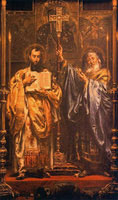
Saints
Cyril and Methodius.
|
| |
Saints
Cyril and Methodius were called the Apostles to the Slavs
because they translated the Bible into the vernacular.
Thanks
to their missionary efforts, the Orthodox faith spread throughout
Eastern Europe.
Rome
and Constantinople were locked in a bitter struggle for
supremacy, so central Europe became the main battleground. |
|
|
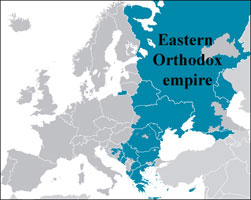
The Eastern
Orthodox empire.
|
By the year 1000
A.D., the Latin West was locked in a bitter struggle for supremacy with
New Rome. The bulwark of the Latin West was the unholy Roman empire
of the German nation.
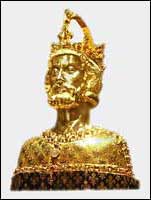
Charlemagne
(742-814).
Reigned as king of the Franks from 768 to 814.
|
| |
In
the Latin West there was a counterfeit Roman empire
called the "Holy" Roman Empire of the German nation.
It was also called the First Reich!!
It
was created by the sword of Charlemagne.
|
|
|
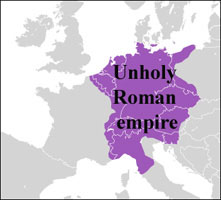
The Latin
empire in the West.
|
This
empire was in constant competition with Orthodoxy and the real
Emperor at Constantinople.
Poland
was actually the religious fault line where these 2 empires met. When
Poland united with Lithuania in 1385, half the population was Greek
Orthodox. Of course this did not bother the Poles who were very tolerant
and did not believe in religious compulsion as practiced by the Latin
Teutonic Knights.
The
Jagiellonian dynasty united Poland and Lithuania in 1385
The
foundation was laid for the later Polish-Lithuanian Commonwealth by
the marriage of Grand Duke Jogaila of Lithuania to Queen Jadwiga of
Poland in 1385.
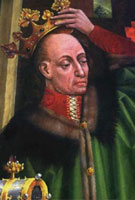
King
Wladyslaw II Jagiello (1362-1434).
Reigned from 1386 to 1434.
|
| |
This
king was Grand Duke of Lithuania and became king of Poland
by marrying Queen Jadwiga of Poland.
This
marriage alliance united the 2 countries in peace and
harmony despite a sizable Orthodox population!!
|
|
|
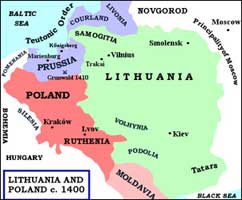
Poland-Lithuania
circa 1400.
|
The king had a Russian
mother and was Orthodox by religion. In order to forestall an invasion
by the Teutonic Knights he converted to the Latin rite.
By this union, Poland
joined a country with a sizeable Orthodox population. This did not bother
the Poles however, as they were always tolerant toward other beliefs:
The other principalities
of south-western Russia, which since the invasion of the Mongols remained
in a very disturbed state, were overrun and conquered almost without
resistance by Gedimin, grand-duke of Lithuania, about 1320. These
principalities, which formed the most important provinces of Lithuania,
became united with Poland by the rule of a common sovereign at the
accession of the Jaguellonian dynasty to the throne of Poland, 1380.
Thus Poland acquired during the fourteenth century, almost without
drawing the sword, several million subjects professing the tenets
of the Greek church. (Krasinski, The Reformation
in Poland, vol. I, p. 101).
By the time of the
blessed Reformation, almost half the population of Poland was Greek
Orthodox:
The union with Rome produced no immediate effect on
the Greek church of Poland and Lithuania; it was established there
much later, and only then when the Jesuits having gained a paramount
influence in that country, oppressed all religious persuasions opposed
to the papal domination; but at the epoch when the reformation of
Luther took place, the oriental church in Poland was in a most flourishing
condition, and its tenets were professed by nearly half of the inhabitants
of the country, amongst whom were many of the noblest families of
the land. (Krasinski, The Reformation in Poland, vol. I,
p. 106).
The
Borgia-Poland Connection
The Borgia crime
family were infamous as POISONERS. Taking the cup of Borgia was synonymous
with death by poisoning. The Borgias had a family member in the Polish
royal family. Her name was Bona Sforza and she was married to the old
king, Sigismund I.
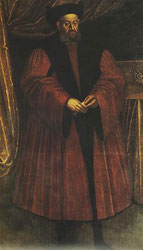
Sigismund
I (1467-1548).
Reigned from 1507 to 1548.
|
| |
Giovanni
Sforza was the first husband of Lucretzia Borgia.
The
old king's first wife, Barbara Zápolya, only reigned
for 3 years until she got the cup of Borgia and had an
timely death at the young age of 20.
Usually
young brides kill old men but in this case it was the
reverse!!
|
|
|
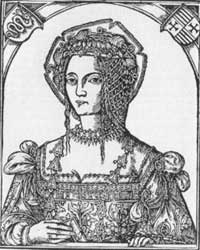
Bona Sforza (1494-1558).
Reigned from 1518 to 1548).
|
Sigismund II Augustus
Jagellon was the son of Sigismund I and Bona Sforza. The Sforza were
linked to the Borgias by the arranged marriage of Lucrezia Borgia to
Giovanni Sforza.
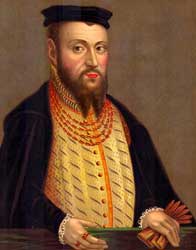
Sigismund
II Augustus (1520-1572).
Reigned from 1530 to 1572.
|
| |
The
reign of Sigismund II was called the Augustan Age in Poland.
The
Reformation spread rapidly throughout the land.
His
first wife, Elizabeth, had a timely demise only 2 years
into her reign.
He
died a very timely death just before the dreadful St. Bartholomew's
Day Massacre. |
|
|
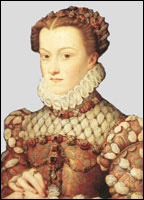
Elizabeth
of Austria (1526-1545).
Reigned from 1543 to 1545.
|
It seems that the
Borgia poison was flowing feeling in Poland after the introduction of
the blessed Reformation.
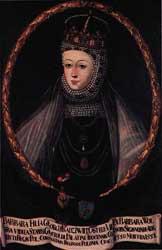
Barbara
Radziwill (1520-1551).
Reigned from 1547 to 1551.
|
| |
Barbara
Radziwill was a Lithuanian princess who greatly favored
the Reformation.
She
was hated by her husband's mother, Bona Sforza,
and had a timely death just 4 years into her reign.
The
king's last wife, Catherine of Austria, died in the same
year as her husband. |
|
|
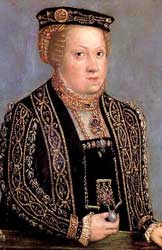
Catherine
of Austria (1533-1572).
Reigned from 1553 to 1572.
|
The
Polish-Lithuanian Commonwealth was established by King Sigismund II
At
the Union of Lublin on July 1, 1569, the Polish-Lithuanian Commonwealth
was officially established.
For
the first time in modern Europe, a king's right to rule was not based
on primogeniture . . . but on election.
This
was a radical and advanced idea for the time and fiercely opposed by
the Jesuits.
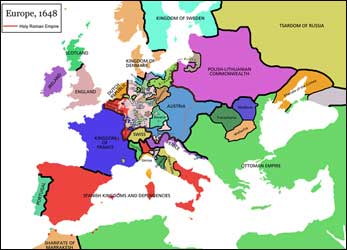 Polish-Lithuanian
Commonwealth circa 1648. Polish-Lithuanian
Commonwealth circa 1648. |
| |
The
Polish-Lithuanian Commonwealth placed the election of the
king on the vote of the parliament or Sejm. |
|
|
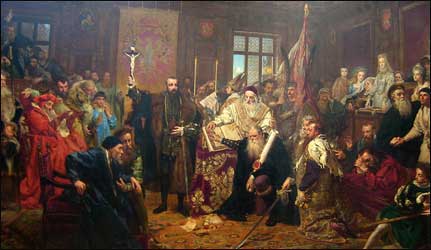 The
Union of Lublin in 1569. The
Union of Lublin in 1569. |
The
foundation of the Commonwealth's political system, the "Golden
Liberty" (Polish: Zlota Wolnosc, a term used from 1573 on), included
these 6 articles:
| 1. |
free
election of the king by all nobles wishing to participate. |
| 2. |
Sejm, the Commonwealth
parliament which the king was required to hold every two years. |
| 3. |
pacta conventa
(Latin), "agreed-to agreements" negotiated with the king-elect,
including a bill of rights, binding on the king, derived from the
earlier King Henry's Articles. |
| 4. |
rokosz
(insurrection), the right of szlachta to form a legal rebellion
against a king who violated their guaranteed freedoms. |
| 5. |
Liberum
veto (Latin), the right of an individual Sejm deputy to oppose
a decision by the majority in a Sejm session; the voicing of such
a "free veto" nullified all the legislation that had been
passed at that session; during the crisis of the second half of
the 17th century, Polish nobles could also use the liberum veto
in provincial sejmiks; |
| 6. |
konfederacja
(from the Latin confederatio), the right to form an organization
to force through a common political aim. |
Cardinal
Hosius invited the Jesuits to Poland in 1564
The
great bulwark of freedom called the Polish-Lithuanian Commonwealth began
its decline when the Jesuits entered in 1564. The Counter-Reformation
immediately sought to gain control of the Polish royal family and use
it to coerce the Triune Christians.
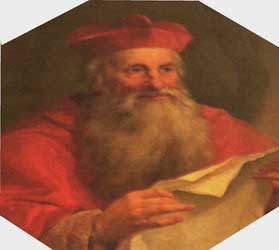
Cardinal
Hosius (1504 1579).
Appointed papal legate in 1566.
|
| |
Stanislaus
Hosius was a bitter persecutor of the Reformed Christians
and he was determined to stop the Reformation at any cost.
He
invited the Jesuits to come and set up the Counter-Reformation.
At
that time, Diego Lainez was the 2nd Black Pope or Jesuit
general. |
|
|
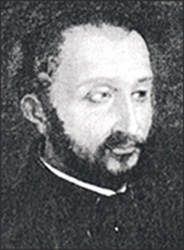
Jesuit
general Diego Lainez.
Black Pope from 1558 to 1565.
|
Obviously
the Jesuits already had a representative in Poland long before that
time in the person of Bona Sforza. The first thing the Jesuits did was
to prepare Poland for a general massacre of the Reformed Christians.
Another
tactic to divide and conquer the Reformed Christians was the introduction
of the ancient Arian heresy that denied the Trinity. This anti-Trinity
doctrine is also held by the Muslims:
It
was at a meeting held in the library of John Trzecieski that a certain
priest named Pastoris, a native of Belgium, attacked the mystery of
the trinity, as being inconsistent with the unity of the Supreme Being.
This doctrine, new at that time in Poland, although broached already
in the works of Servetus, startled in such a manner the members present,
that they became mute with astonishment, perceiving with terror that
such a proposition would lead to the subversion of revealed religion.
This doctrine, adopted by several members of the above-mentioned society,
laid in Poland the foundation of that sect whose opinions became afterwards
known under the name of Socinianism, although neither Lelio nor Faustus
Socinus may be considered as its true founders. The same daring propositions
had undoubtedly the effect of frightening many timorous minds, and
of deterring them from any further attempt against the abuses and
errors of Romanism, so that they preferred to remain in the pale of
the established church, in spite of its acknowledged aberrations,
rather than to venture on a dangerous course which might lead them
to a pure deism, and reduce the gospel to a simple code of morality.
There were many however who, firm of mind and inspired with true piety,
resolved to search the truth, not by the sole guidance of human reason,
but by the test of the Holy Scriptures. (Krasinski,
The Reformation in Poland, vol. I, pp. 139-140).
Several
sects grew like mushrooms espousing this ancient heresy so that it greatly
undermined the work of the Reformation in Poland.
A
Polish St. Bartholomew's Day Massacre!!
After the very timely
death of King Sigismund on August 8, 1572, Poland elected a new king.
The new king was none other than the French Henry of Valois, son of
the infamous poisoner Catherine Di' Medici.
| 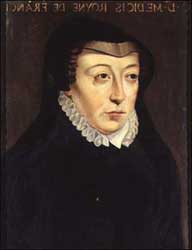
Catherine
de' Medici (1519-1589). Queen Consort of France from 1547-1559.
|
| |
Catherine
de' Medici was the virtual ruler of France from 1559 until
her death.
She
engineered the horrible St. Bartholomew's Day Massacre in
that country.
She
planned to do the same in the Polish-Lithuanian Commonwealth.
|
|
|
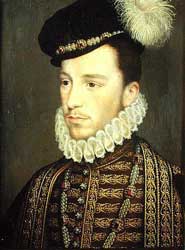
Henry of
Valois (1551-1589).
King of Poland from 1573 to 1574.
|
Henry was highly
displeased when he had to sign a compact that guaranteed religious toleration
in his new kingdom. He was very unhappy by this restriction on his absolute
power to carry out his plans for a massacre, so when the French throne
became vacant by the death of his brother Charles IX, he secretly returned
to France.
The
General Confederation of Warsaw guaranteed religious liberty to all!!
Because
of the dreadful massacre of St. Bartholomew, the Polish nobility had
King Henry sign a declaration of RELIGIOUS LIBERTY known as the General
Confederation of Warsaw. No document like it was to appear until the
U.S. Bill of Rights in 1791:
And
whereas in our Commonwealth there are considerable differences in
the Christian religion [jest dissidium niemale in cause religionis
christianae], these have not caused disorders [sedycyja] among people,
as detrimental as have begun in other kingdoms that we have clearly
seen, we promise to one another, for ourselves and for our descendants,
for all time, pledging our faith, honor and conscience, we swear [pro
nobis et successionibus nostris in perpetuum, sub vinculo iuramenti,
fide, honore et consientiis nostris], that we
who are divided by faith [dissidentes de religione], will keep peace
among ourselves, and not shed blood on account of differences in faith
or church [dla roznej wiary i odmiany w Koscielech], nor will
we allow punishment [penowac] by the confiscation of goods, deprivation
of honor, imprisonment or exile, nor will we in any fashion aid any
sovereign or agency [urzedowi] in such undertakings. And certainly,
should someone desire to spill blood on such account [ex ista causa]
we all shall be obliged to prevent it, even if the person uses some
decree as pretext or cites some legal decision. (General
Confederation of Warsaw).
Of
course religious liberty and non-use of force is absolutely condemned
by the Papacy. These articles of civil and religious liberty were a
death sentence for Poland. Here is a quote from the Syllabus
of Errors:
79.
Moreover, it is false that the civil liberty of every form of worship,
and the full power, given to all, of overtly and publicly manifesting
any opinions whatsoever and thoughts, conduce more easily to corrupt
the morals and minds of the people, and to propagate the pest of indifferentism.
—Allocution "Nunquam fore," Dec. 15, 1856. (Condemned
as error).
King
Stefan Batory allowed the Jesuits free reign in Poland-Lithuania
Because
King Sigismund II had no male heirs despite having married 3 times,
the Republic elected Stefan Batory to the throne after the speedy exit
of the French king.
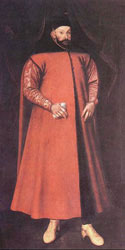
King
Stefan I Batory (1533- 1586).
Reigned from 1576 to 1586.
|
| |
During
the reign of King Stefan Batory, the Jesuits spread their
tentacles all over the Republic.
His
wife, Anna Jageillon, was the daughter of King Sisigmund
I and Bona Sforza. |
|
|
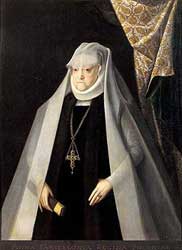
Anna
Jageillon (1523-1596).
Reigned from 1574 to 1587.
|
The
king was probably persuaded to cooperate with the Jesuits by fear of
the cup of Borgia and the influence of his wife, Anna:
Although
Stephen Battory strictly maintained the laws protecting the religious
liberties of the nation, and promoted merit, without reference to
religious persuasion, the Jesuits unfortunately insinuated themselves
into his favour; and indeed Battory, whose feign of ten years is one
of the most glorious epochs in the annals of Poland, may be considered
as having greatly contributed to its future decline, by establishing
the influence of that order in his dominions. Supported by his patronage,
the Jesuits' colleges and schools spread all over the country, and
he laid the foundation of their chief seat in Poland, the university
of Vilna, which, notwithstanding the opposition of the Protestants,
who foresaw the dangers which threatened them from that quarter, he
established in the centre of a population, a large majority of which
was anti-Romanist (Protestant and Greek). The erection of the university
of Vilna and of the college in the newly-conquered town of Polotsk,
by the sole authority of the monarch, was unconstitutional, and as
such strongly attacked by the diet of 1585; but the influence of the
king prevailed over the opposition of the diet, and the privileges
of these foundations were confirmed. (Krasinski, The
Reformation in Poland, vol. I, pp. 52-53).
The
Reformation was finally destroyed in Poland when the country was broken
up between Russia, Prussia and Austria.
Pope
Clement XIV banned the Jesuit Order by a perpetual decree!!
On July 21, 1773,
this "infallible" Pope banned the Jesuit order by a perpetual
decree never to be rescinded.
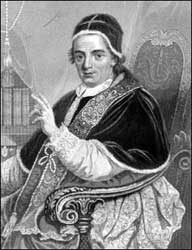
Pope Clement
XIV (1705-1774).
Pope from 1769 to 1774.
|
Pope
Clement XIV banned the Jesuits by a perpetual decree never to
be rescinded.
The
last Black Pope or Jesuit general should have been Lorenzo Ricci.
|
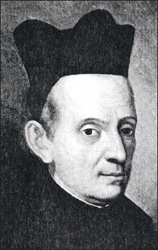
Lorenzo
Ricci (1703-1775).
General from 1758 to 1775.
|
Clement knew from
history what happened to Popes who opposed the Jesuits....He hesitated
before signing the decree but eventually was FORCED to do so by most
of the sovereigns of Europe:
And
to this end a member of the regular clergy, recommendable for his
prudence and sound morals, shall be chosen to preside over and govern
the said houses; so that the name of the Company shall be, and
is, for ever extinguished and suppressed.
(Bull of Suppression of Pope Clement
XIV).
The
Jesuits were banned from most of the countries of Europe and the Spanish
Jesuits ended up on the island of Corsica. Napoleon Bonaparte was born
on that island in 1769 and he restored the Jesuits in 1814.
Pope
John Paul II was about to fire the Jesuit general before he was shot!!
Just
3 weeks prior to the assassination attempt, Pope John Paul II had
a meeting with 6 of the most powerful cardinals in the Vatican. The
topic: the forced resignation of the Jesuit general Pedro Arrupe:
In some respects, the
meeting that convened in the middle of spring 1981 bore the marks of
thousands of board meetings going on at the same moment in every daylight
country of the world. Beyond glass-paneled double doors, a conference
between seven men was in progress. A folder bulging with reports lay
in front of each man. At each man's elbow a full carafe of water topped
with a glass was perched. Anyone happening to glance in might have said
that the men gathered there were absorbed in the sort of hushed but
free-wheeling discussion typical of board meetings everywhere.
But this was not the sort of meeting most people have ever witnessed,
or even glimpsed through shut, glass-paneled doors. This conference
room was on the third floor of the Palace of the Popes on Vatican Hill.
The report folders were red damask and emblazoned in gold with the Tiara
and Keys. Outside the door, a secretary and two Swiss Guards in traditional
uniform were on duty to block all intruders. Seated at the conference
table were the Pontiff of the Holy Roman Catholic Church and six of
his most powerful cardinals, the movers and shakers of the Vatican,
a cameo of its most formidable strength. And the
subject of discussion between them was the life or death of the Society
of Jesus:whether, in other words, the Order headed by Father General
Pedro Arrupe should be allowed to go on as it was, or be reorganized
and reset according to the often-repeated wishes of three Popes, or
be officially done to death by the power and under the authority of
Pope John Paul II. (Martin, The Jesuits, pp. 79-80).
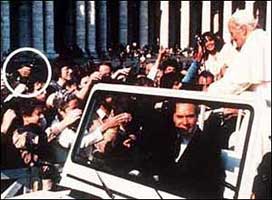
A hand
holding a gun aims from the crowd at Pope John Paul II as he
rides through Vatican City Square on May 13, 1981.
|
| |
Pope
John Paul II was about to abolish the Jesuits when he
was shot 3 times in Vatican City Square.
The
gunman was a Muslim Turk named Mehmet Ali Agca.
Of
course the Russian KGB was blamed for the shooting!!
|
|
|
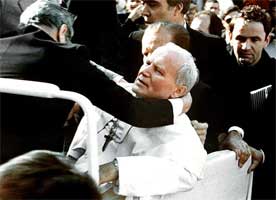
Pope
John Paul II was shot 3 times
at point blank range.
|
The Polish Pope
was shot 3 times by Turkish gunman Mehmet Ali Agca on May13—the
Latin Feast of our Lady of Fatima.
The Pope had dared
to mess with the Jesuits . . . and that was a death sentence.

Pedro
Arrupe (1907-1991).
Black Pope from 1965 to 1983.
|
| |
Pedro
Arrupe was the 28th Black Pope or Jesuit general.
General
Arrupe survived ground zero at Hiroshima, Japan, on August
6, 1945.
As
revenge for the shooting, he got a massive
stroke at Rome airport on August 7, 1981. |
|
|
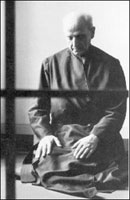
General
Arrupe was at ground
zero in Hiroshima, Japan.
|
On August 7, 1981,
after returning from a trip to the Far East,
Arrupe suffered a massive stroke just after his airplane had landed
at Rome's Fiumicino Airport. He was paralyzed on his right side and
was able to spseak only a few words. He was the first Jesuit general
to resign instead of remaining in office until his death.
Vital
Links
References
Biskupski,
M.B. The
History of Poland.
Greenwood Press, Westport, Connecticut, 2000.
Fusero
Clemente, The Borgias. Praeger Publishers, New York & London,
1972.
Krasinski,
Count Valerian. Historical
Sketch of the Rise, Progress, and Decline of the Reformation in Poland.
(Volume I). London, 1838.
Krasinski,
Count Valerian. Historical
Sketch of the Rise, Progress, and Decline of the Reformation in Poland.
(Volume II). London, 1840.
Martin,
Malachi. The Jesuits: The Society of Jesus and the Betrayal of the
Roman Catholic Church. Simon & Schuster, New York, 1989.
Copyright
© 2013 by Patrick
Scrivener
Back
to Main Menu |

























